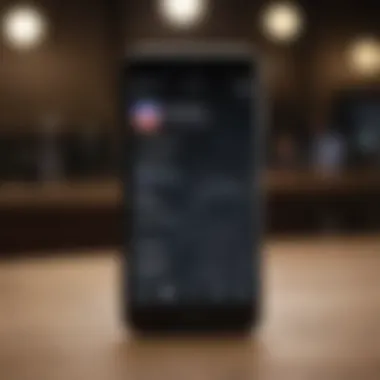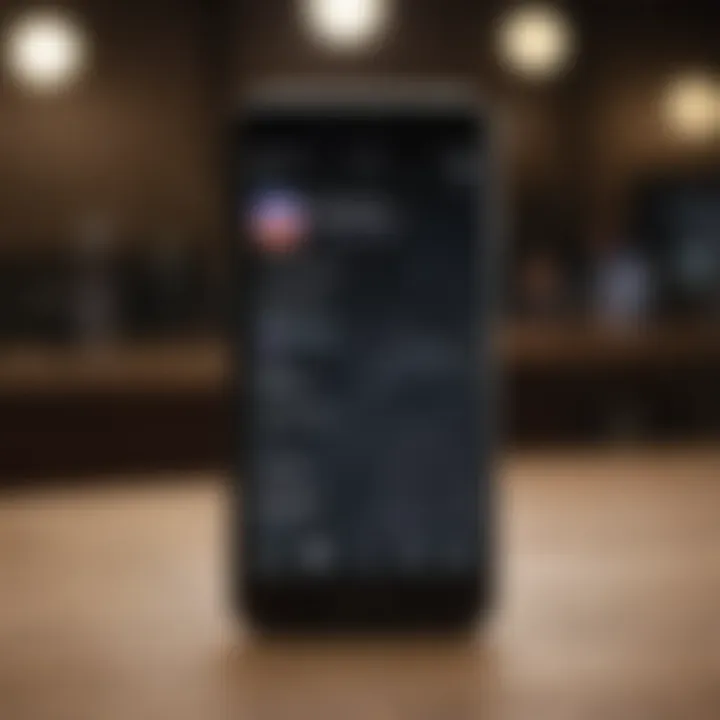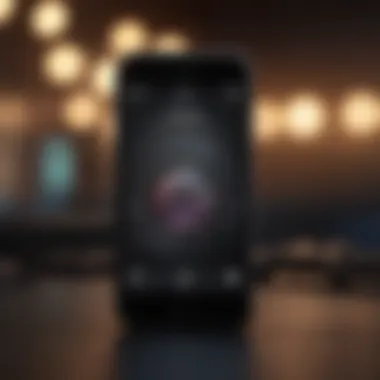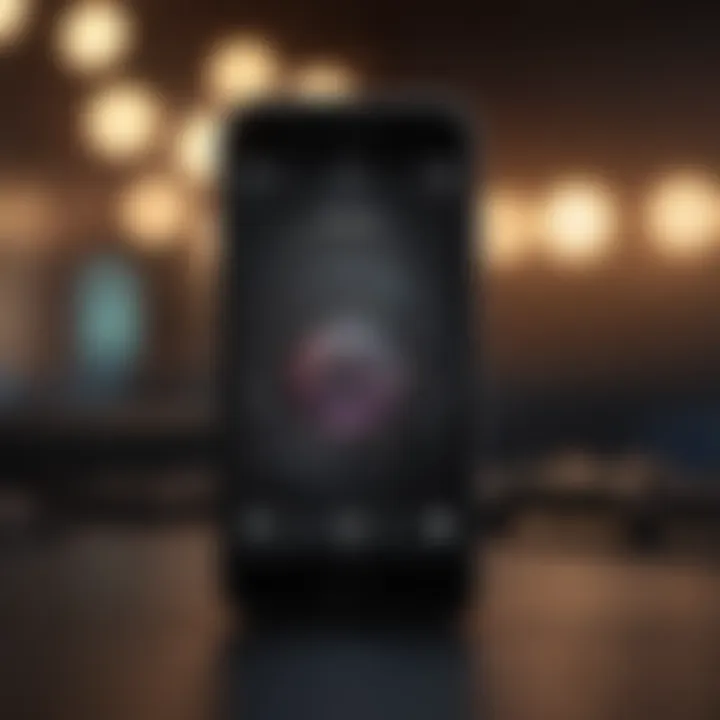Changing Your Ringtone on iPhone 7: A Comprehensive Guide


Product Overview
The iPhone 7 stands out in Apple's lineup, bringing a series of noteworthy features to the table. Released in September 2016, this smartphone is known for its sleek design and robust build quality. With an aluminum body and water-resistant capabilities, it blends aesthetics with functionality. The display boasts a 4.7-inch Retina HD screen, which enhances the visual experience for users.
Key Features and Specifications
The iPhone 7 is powered by the Apple A10 Fusion chip, providing efficiency and speed that caters to varied user needs. It comes equipped with 32GB, 128GB, or 256GB storage options. Additionally, it offers a decent battery life, lasting up to 14 hours in talk time. With 12MP rear and 7MP front cameras, it captures sharp and vibrant images, enhancing the overall user experience.
Design and Aesthetics
Its minimalist design, available in various color options, including Jet Black and Rose Gold, appeals to a broad audience. The home button features a solid-state design that uses haptic feedback, making it a unique aspect of the device. The screen is covered by a durable glass, ensuring longevity and resistance to daily wear and tear.
Performance and User Experience
Performance Benchmarks
When it comes to performance, the iPhone 7 excels with its A10 Fusion chip. This processor provides significant improvements over previous models, showing better graphics performance and efficiency in battery usage. Users report smooth multitasking capabilities, which is crucial for those who use their devices for both work and leisure.
User Interface and Software Capabilities
Running on iOS, the iPhone 7 offers an intuitive user interface. The software allows customization, including changing ringtones, text tones, and other notification sounds. This customization is vital for personal expression and enhancing user satisfaction.
User Experiences and Feedback
Feedback from users generally indicates satisfaction with the smoothness of operations. However, some identify the lack of a headphone jack as a minor inconvenience, prompting a shift to wireless solutions. Overall, the cohesive integration of hardware and software makes for a reliable experience.
Comparison with Previous Models or Competitors
Advancements and Improvements from Previous Models
Compared to the iPhone 6s, the iPhone 7 achieves significant advancements, particularly in camera technology and processing speed. The A10 Fusion chip outperforms the A9 chip found in the 6s, resulting in faster app launch times and better performance during intensive tasks.
Competitive Analysis with Other Similar Products
In comparison to competitors, like the Samsung Galaxy S7, the iPhone 7 holds up well. Both offer compelling features; however, Apple's ecosystem provides a more seamless experience for users heavily invested in Apple products. The integration of services like iCloud, Apple Music, and AirDrop enhances the overall value.
Value Proposition
The iPhone 7 offers excellent value for Apple enthusiasts, providing a reliable device with an array of features. Users often appreciate the long-term software support, which keeps the device relevant for years.
Tips and Tricks
How-to Guides and Tutorials for Optimizing the Apple Product's Performance
To maximize utility, users should explore built-in features. For instance, enabling Low Power Mode can extend battery life during intensive use.
Hidden Features and Functionalities
Changing the ringtone can personalize alerts and improve the user experience. Users can select different tones for messages, calls, and alerts, tweaking settings to suit their preferences.
Troubleshooting Common Issues
Common issues include ringtone not playing or default settings not saving. Restarting the device often resolves minor glitches. Additionally, ensuring software is updated can prevent many problems.
Latest Updates and News
Recent Developments in Software Updates and New Features
Apple regularly updates iOS, which occasionally brings features specific to ringtone customization. For example, new sounds may become available after an update, enhancing personalization options.
Industry News and Rumors Surrounding Upcoming Products
Speculation about new iPhone models often circulates. Apple enthusiasts are always eager for announcements about advancements in technology that may be included in future devices.
Events and Announcements from Apple
Apple's annual events frequently introduce new software and hardware innovations. Users often look forward to these events to learn about the future of their devices and the ecosystem they are part of.


"Understanding how to customize your experience makes the iPhone 7 not just a communication device, but a personalized tool for everyday life."
Understanding the Ringtone Functionality on iPhone
Ringtone functionality is a vital aspect of the user experience on the iPhone 7. Sound notifications serve not just utilitarian purposes but also contribute to personal expression and connectivity in a digital age. Customizing ringtones offers both aesthetic pleasure and practical advantages.
Let's explore what makes ringtone functionality significant. First, it directly influences how users experience incoming calls and alerts. A distinct ringtone helps users swiftly identify who is calling or texting without needing to look at the screen. This can be particularly useful in professional settings, where distinguishing between contacts might be crucial.
It also creates an opportunity for personalization. Users can choose sounds that resonate with their personality or mood. This allows for a more engaging interaction with the device. Ringtones can reflect one's style, ranging from classical tunes to modern pop hits. Choosing the right sound can even enhance the enjoyment of interacting with one's phone.
Considerations about the ringtone functionality also include the technical aspects of sound customization. The iPhone 7 allows users to import custom ringtones, providing a wealth of options beyond the standard choices. This versatility can cater to various user preferences and scenarios. Additionally, battery performance and sound clarity are paramount. Ringtones must not only be distinct but also loud enough to be heard in different environments. Effectively, the quality of the ringtone affects its usability in daily life.
"The ability to customize ringtones is not merely about aesthetics; it is about enhancing user experience and connectivity in a fast-paced world."
Overall, understanding the ringtone functionality is crucial for making informed decisions about sound settings on the iPhone 7. It encourages users to explore various tones and personal preferences, enabling a deeper connection to their device.
Initial Settings for Ringtone Customization
Changing ringtones on your iPhone 7 requires some initial settings adjustments. This step is crucial. It ensures the device accommodates your customizations and that you can access all available options without hitches. Perfecting the initial settings sets the tone for the entire customization process. The effects of these settings can be seen in how your preferences translate into audible alerts.
Accessing Settings on Your iPhone
To begin, you will need to access the Settings app on your iPhone. This application houses all controls associated with the device's customizable features. Here’s how you can do this:
- Locate the Settings icon on your home screen. It looks like a gear.
- Tap on the icon to launch the app.
- Once in the settings menu, you will find a range of categories related to device functions.
By accessing the Settings menu, you now have a gateway to adjust various functionalities. It is the first and foremost step in personalizing the sound settings, ensuring you can choose ringtones as you prefer.
Navigating to Sounds and Haptics
Now that you are in the Settings, your next move is to navigate to the Sounds & Haptics section. This area allows you to modify sound settings, from ringtones to alerts. Follow these steps:
- In the Settings menu, scroll down until you see Sounds & Haptics.
- Tap on it to enter.
Once inside, you will see a list of customizable tone options. Each option represents a different sound category, including ringtones, text tones, and alert sounds. This section is essential, as it provides the tools necessary for tailoring your ringtone experience.
By understanding the importance of these initial settings, you set a strong foundation for further personalization. A well-configured Sound & Haptics section leads to a more satisfying user experience.
Using Built-In Ringtones
Using built-in ringtones on iPhone 7 presents a convenient option for users seeking to personalize their sound experience without the hassle of importing or creating custom tones. The built-in ringtones not only offer a solid variety of options, but they also integrate seamlessly with the device. This method is straightforward, providing immediate accessibility that is often preferred by those who value efficiency over extensive customization.
One of the significant advantages of using preloaded ringtones is the quality. Apple has designed these sounds to ensure clarity and an appealing auditory experience. This consideration is essential, especially for users who rely on their phone's notifications to discern different alerts quickly. By choosing from the built-in options, users can easily switch between tones without having to delve into complex settings or third-party applications.
Selecting from Preloaded Options
Apple offers a diverse library of ringtones that cater to different styles and preferences. During the selection process, users can take time to explore the variations available within the settings. The users might find classic tones as well as modern sounds suitable for a variety of contexts, from professional settings to casual environments.
To locate these options:
- Open the Settings app on your iPhone 7.
- Navigate to Sounds and Haptics.
- Tap on Ringtone to reveal the list of preloaded ringtones.
This list contains an assortment of sounds, and users are encouraged to scroll through to find their favorites.
Previewing Ringtones
Previewing ringtones before selecting one is an excellent feature that enhances the customization process. Users can listen to each sound by simply tapping on the ringtone name. This functionality allows for informed decision-making, ensuring that the chosen ringtone aligns perfectly with the user's style or the intended message.
It is important to remember that the initial preview may not fully capture the ringtone's effect during incoming calls. Therefore, after making a selection, it is advisable to test it out while having someone call to confirm the choice fulfills expectations.
In summary, using built-in ringtones on iPhone 7 provides immediate access to a range of high-quality sounds, simplifying the customization process. The ability to preview each option creates a more satisfying experience. By selecting the right built-in ringtone, users not only improve personal satisfaction but also enhance communication efficiency.
"User experience is vital; choosing the right sound can impact perception and alertness to notifications."
For more information about ringtones and audio settings, one can refer to resources like Wikipedia or Britannica.
The built-in ringtones serve both functions of utility and personalization, making it a worthwhile consideration for both casual and professional users alike.


Importing Custom Ringtones
Importing custom ringtones can greatly enhance your device's auditory experience. Many users seek personalized sounds that reflect their personality or preferences. This aspect also allows for a deeper connection with your iPhone 7, creating a unique sense of ownership. Custom ringtones can help differentiate your device in a sea of similar devices. In addition to mere novelty, they also offer practical benefits, like easily identifying calls and alerts without having to check the screen. This section covers how to import ringtones, including using iTunes and third-party applications.
Using iTunes for Customization
Using iTunes for ringtone customization is a tried and true method. It provides users with a straightforward way to transfer audio files to their device. With this method, you can choose from various audio files you already have or download new ones. The process can seem complicated, but each step is crucial for successfully getting those sounds onto your iPhone.
Downloading Ringtone Files
Downloading ringtone files is a simple yet important step. You can obtain a variety of audio tracks from numerous online resources. Some services offer free options, while others may require a payment. The key characteristic of this step is the accessibility of various genres and styles of music.
Downloading gives you the ability to choose exactly what you want. This flexibility is a significant advantage. However, be cautious of the file formats; the best choices for importing ringtones are usually .m4r or .mp3 formats. If a file is not in the right format, it may not transfer correctly.
Uploading to iTunes
Once you have the ringtone files ready, the next step is uploading them to iTunes. This step is very important as iTunes serves as the bridge between your computer and your iPhone. The process involves selecting your audio files in iTunes and ensuring they are appropriately converted into ringtones. This can be done via the "File" menu. The benefit of using iTunes lies in its robust library management capabilities, making it easy to keep track of your files.
However, users must ensure that the audio files meet iTunes requirements to be uploaded successfully, which can be a hurdle for some.
Syncing with iPhone
Syncing with iPhone is the final and most crucial step. After uploading, you must sync the ringtones to your device. This ensures that your custom sounds appear in the ringtone library on your iPhone 7. The sync process is fairly automatic once iTunes is connected to your device. This integration allows for a seamless experience after the initial setup.
However, syncing can sometimes lead to complications, particularly if there are many files involved or if the device settings are not optimized. It's important to regularly check your settings and preferences to avoid potential issues.
Utilizing Third-Party Applications
Utilizing third-party applications provides another avenue for customized ringtones. These apps can simplify the process significantly, as many are user-friendly and designed specifically for ringtone creation. They often have unique features that set them apart. Choosing the right apps is very important. Attention to user reviews and ratings can guide you in selecting reliable options for your ringtone needs.
Choosing Reliable Apps
Choosing reliable apps is essential, as the app landscape is vast and varied. It is very beneficial to opt for applications with strong user reviews. A good app will offer both quality and a user-friendly interface. Many apps also feature wide-ranging options for ringtone selection and customization. However, some apps may include ads or in-app purchases that might detract from the user experience.
Steps for App-Supported Ringtone Creation
Steps for app-supported ringtone creation are generally intuitive, making this method appealing. Most popular ringtone apps have in-app tutorials to guide users through the process of creating their own ringtones. This characteristic makes them accessible to a broader audience without requiring extensive technical knowledge. However, users should also be aware of potential subscription fees, which can be a disadvantage. Every app has distinct steps, so familiarize yourself with the specific app you choose.
Setting a New Ringtone for Incoming Calls
Setting a new ringtone for incoming calls is vital for iPhone 7 users, as it adds a layer of personal expression and practicality to one’s device. Ringtones not only signify that a call is incoming but can also reflect the user’s personality or mood. In busy environments, a distinct ringtone helps identify one’s phone without checking the screen. This adds convenience in various scenarios where a quick response is essential.
Additionally, customizing ringtones may minimize confusion when receiving calls from multiple sources. Recognizing a ringtone connected to a specific contact can aid in making prompt decisions regarding pickups. Overall, assigning ringtones can enrich the user experience and enhance efficiency during phone interactions.
Choosing Your Default Ringtone
To choose your default ringtone on iPhone 7, follow these steps:
- Open the Settings app on your home screen.
- Scroll down and tap Sounds & Haptics.
- Select Ringtone.
- Browse through the available ringtones.
- Tap the one you wish to use.
- A checkmark will appear next to your selected ringtone, indicating it is now your default setting.
When selecting a ringtone, consider clarity and uniqueness. A clear and distinct ringtone stands out in noisy environments, enabling you to recognize calls even when your phone is not directly in view.
Assigning Ringtones to Contacts
Assigning unique ringtones to your contacts elevates the personalization of your iPhone 7 experience. Here’s how to do it:
- Open the Contacts app or tap on the Phone icon and then Contacts.
- Select the contact you wish to modify.
- Tap Edit at the top right of the screen.
- Scroll down to Ringtone and tap it.
- Choose the desired ringtone from the list.
- Tap Done to save your changes.
By assigning different ringtones, you can easily distinguish who is calling without checking your phone. This feature is particularly useful in professional settings or social gatherings, where a quick glance can reveal if the call is important or can wait. The simplicity of customizing your ringtone ensures that you maintain control over your communication environment.
Adjusting Vibration Settings Alongside Ringtones
Adjusting vibration settings is an essential aspect of personalizing your iPhone experience. While ringtones provide auditory alerts, vibrations add a tactile dimension, ensuring you never miss important notifications. For professionals or individuals in loud environments, the combination of ringtones and vibrations is especially beneficial. Custom vibrations can signal different alerts, making it easier to identify calls or messages without even looking at the screen.
When you tailor these settings, you enhance your responsiveness to communications. Different vibration patterns can help distinguish between various types of notifications. For instance, someone might use a soft pulse for a text message and a more intense pattern for an incoming call. This section will explore the possibilities of creating custom vibration patterns and the steps to implement them effectively, ensuring you have a fully personalized alert system that suits your lifestyle.
Custom Vibration Patterns


Creating custom vibration patterns is straightforward and adds a layer of personalization to your device. Here’s how to set up custom vibrations on your iPhone 7:
- Access Settings: Start by opening the Settings app on your iPhone.
- Select Sounds & Haptics: Tap on the "Sounds & Haptics" option. Here, you can manage your ringtones and vibration settings.
- Choose Vibration: Scroll down to find the "Vibration" option. Tap on it to see the default patterns.
- Create New Vibration: There is an option to create a new vibration pattern at the bottom.
- Tap to Create: Start tapping on the screen to create your preferred vibration pattern. You can experiment with the timing and intensity of your taps until you find a pattern that feels right to you.
- Save Your Vibration: Once satisfied, you can save your vibration pattern by giving it a name.
These custom vibrations can be assigned to different contacts or alerts within the settings, helping you distinguish between different notifications quickly. This is particularly useful for managing multiple points of communication without confusion.
Custom vibrations not only ensure you can identify notifications discreetly, they also allow greater customization based on personal preference.
Troubleshooting Common Ringtone Issues
Understanding how to troubleshoot common ringtone issues is essential for users of the iPhone 7. It is not uncommon to encounter difficulties when trying to change or set a ringtone. Addressing these issues quickly not only enhances your user experience but also ensures that you stay connected in crucial moments. The following sections will delve into the common problems users face and provide clear methods to resolve them.
Ringtone Not Playing
If your iPhone 7’s ringtone does not play as expected, it can be frustrating. There are several reasons why this may happen. First, check the volume settings on your device. Sometimes, the volume may be turned down too low, or the device might be set to silent mode.
- Ensure the mute switch on the side of the iPhone is not activated.
- Go to the Settings app, then tap on Sounds & Haptics to adjust the volume slider.
Another reason could be linked to the chosen ringtone itself. Sometimes, the ringtone might be corrupted or incompatible. You can try selecting another ringtone to see if that resolves the issue. If you have custom ringtones, ensure they are formatted properly for use on iPhone. Generally, ringtones should be in .m4a format to work seamlessly.
Tip: Always keep your iOS updated to avoid glitches with ringtones and other features.
Ringtone Not Syncing from iTunes
If your ringtones do not sync from iTunes to your iPhone 7, it can be a matter of several factors. First, check that both your iTunes and iPhone are using the same Apple ID, especially if you sync over Wi-Fi.
- Make sure that your iTunes is running the latest version. Outdated software could cause synchronization issues.
- Connect your iPhone to your computer using a USB cable. Open iTunes, select your device, and ensure that Sync Tones is enabled.
- If you have recently updated your ringtones in iTunes, they might need to be re-synced manually.
If the problem persists, sometimes removing and then re-adding the ringtones can clear any issues with the files.
Finally, restarting both your iPhone and iTunes can help restore proper functionality. Regular issues with syncing can often be alleviated by these simple steps.
Alternative Sound Notifications
Understanding how to personalize your iPhone experience goes beyond just setting a ringtone. Alternative sound notifications play a crucial role in how you receive alerts and notifications. They can affect your productivity and responsiveness.
Alternative sound notifications include various sound settings that notify users about different events, such as messages, emails, or reminders. Knowing these options enhances your ability to customize your device according to your lifestyle. You can set distinctive tones for different alerts, allowing you to quickly identify the nature of the notification without having to look at your screen.
Using alternative sound notifications has several advantages. For instance:
- Improved Organization: Different sounds can help categorize alerts. This reduces confusion, especially when multiple notifications come in at once.
- Enhanced Focus: Setting less intrusive sounds for non-urgent notifications can help maintain concentration during work hours.
- Personal Expression: Unique sounds allow users to express their personality and preferences more effectively.
However, while customizing sound notifications, there are considerations to keep in mind. For example, a sound that might work as an alert during the day could be distracting during meetings. Furthermore, some sounds may not be suitable in quiet environments.
"Choosing the right sound for notifications can significantly enhance user experience and productivity, particularly in professional settings."
In summary, integrating alternative sound notifications into your iPhone experience enhances functionality and personalization. This section sets the stage for understanding alert tones, which work in tandem with ringtones to fully leverage your device's capabilities.
Alert Tones vs. Ringtones
When discussing sound notifications, it is essential to distinguish between alert tones and ringtones. While both serve to alert users, they function in different contexts and are designed for different types of notifications.
Ringtones are primarily used for incoming calls. They are intended to signal someone when they are trying to reach you. A unique ringtone can make identifying who is calling easier.
On the other hand, alert tones are utilized for various system notifications such as text messages, app alerts, and reminders. These sounds often tend to be shorter and subtler compared to ringtones. Each app usually has its sound settings that allow users to customize how they receive notifications for app-specific alerts.
Here are some key differences:
- Purpose: Ringtones are for voice calls, while alert tones are for messages and notifications.
- Length: Ringtones can be longer, while alert tones are shorter and more abrupt.
- Settings Location: Ringtones are set in the ringtone menu, while alert tones are often configured within each app's settings.
Choosing the right type of sound for your needs can greatly improve your interaction with your device. Careful selection can provide clarity and ease of use when managing notifications, thus maximizing efficiency.
The End
In every aspect of smartphone usage, personalization matters. Changing your ringtone on the iPhone 7 is more than just a procedure; it embodies the user’s desire to express individuality and enhance their communication experience. The importance of this action is rooted in both functionality and personal identity.
First, a custom ringtone allows users to quickly identify incoming calls. In a world filled with constant notifications, associating specific sounds with certain contacts helps differentiate communications. This is particularly valuable in professional settings where prompt responses are crucial.
Additionally, employing custom ringtones or alert tones adds a layer of enjoyment and personalization to daily interactions. A static, default sound may be serviceable, but it lacks the emotional connection users often seek. By selecting tunes that resonate with personal tastes, users can transform the mundane act of answering a phone call into a more engaging experience.
However, while the steps to change ringtones are straightforward, understanding potential issues and solutions enhances the utility of this feature even further. Familiarity with troubleshooting, such as problems with syncing ringtones from iTunes or playback failures, allows for a smoother experience, especially when setting up custom notifications.
Overall, the ability to customize ringtones on the iPhone 7 stands as a significant feature within the operating system. Not only does it foster a sense of ownership over the device but it also contributes to efficient communication. By engaging with these settings, users are better equipped to enjoy their device fully.
This guide has detailed the significant aspects of ringtone customization and its benefits, encouraging users to take full advantage of their iPhone 7’s capabilities.



